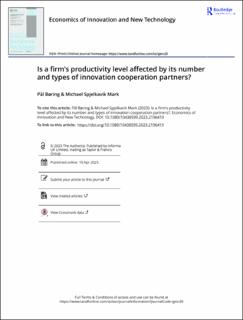Is a firm's productivity level affected by its number and types of innovation cooperation partners?
Peer reviewed, Journal article
Published version
Permanent lenke
https://hdl.handle.net/11250/3062564Utgivelsesdato
2023Metadata
Vis full innførselSamlinger
Originalversjon
10.1080/10438599.2023.2196419Sammendrag
We first examine the effect of having innovation cooperation arrangements on the productivity level among firms with innovation activities. Then, we examine whether a firm’s productivity level is affected by its number and types of innovation cooperation partners among those with innovation cooperation arrangements. Data on Norwegian firms with innovation activities is used. In the analysis, we differentiate between small and large firms. The estimation results show that unlike small firms, large firms can benefit from cooperation arrangements by achieving productivity improvements. Using the group of internal partners as the reference category, the results show that the productivity level is relatively higher in the short term among all and small firms that had cooperation arrangements with competitors or other enterprises in their sector, and relatively lower both in the short and medium term among all and small firms that had arrangements with partners in the academic sector. This level is relatively higher among large firms that had arrangements with consultants or consulting enterprises, and relatively lower among large firms that had arrangements with commercial labs or R&D-enterprises, in the medium term. We also find that most effects of the number of different types of cooperation partners are not significant.
